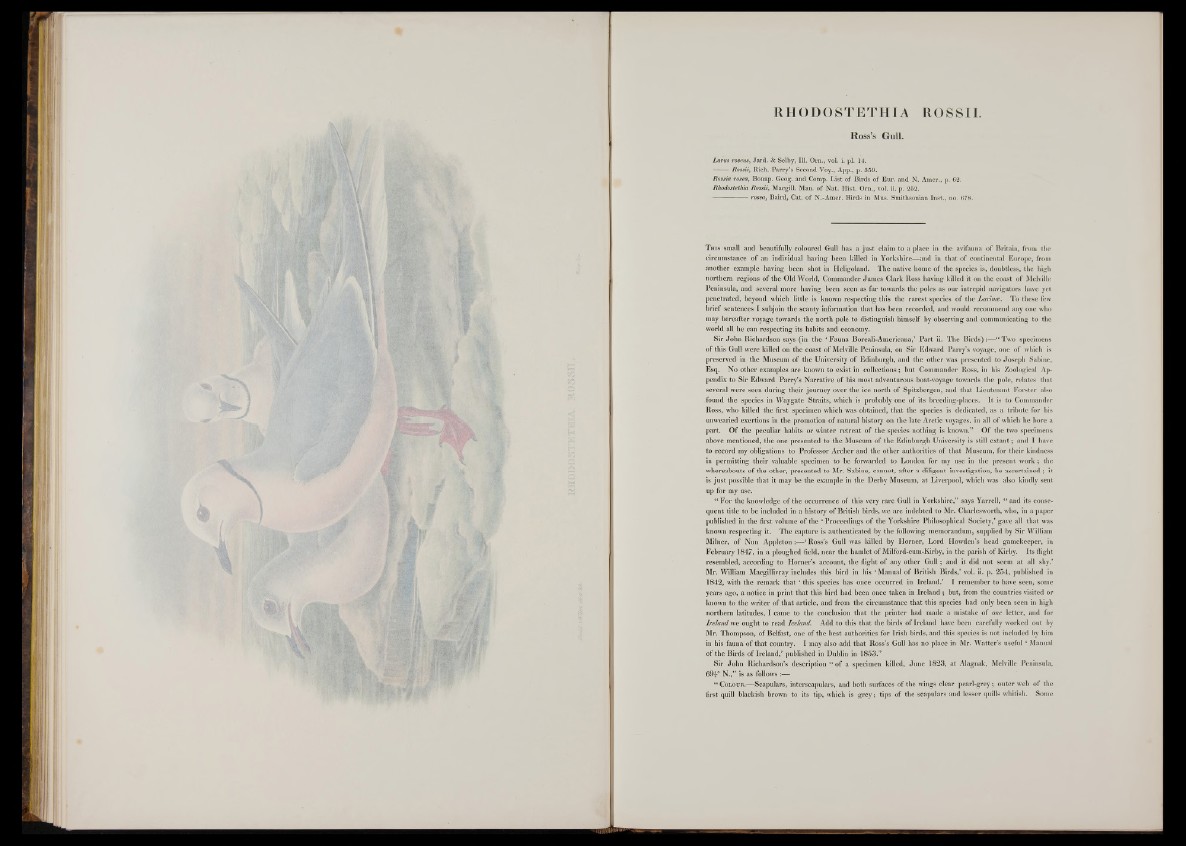
RHODOSTETHIA ROSSII.
Ross’s Gull.
Larus roseus, Jard. & Selby, 111.'Ora., vol. i. pi. 14.
Rossii, Rich. Parry’s Second Voy., App., p. 359.
Rossia rosea, Bonap. Geog. and. Comp. List of Birds of Eur. and N. Amer., p. 62.
Rhodostethia Rossii, Macgill. Man. of Nat. Hist. Orn., vol. ii. p. 252.
----------------rosea, Baird, Cat. of N.-Amer. Birds in Mus. Smithsonian Inst., no. 678.
T h is small and beautifully coloured Gull has a just claim to a place in the avifauna o f Britain, from the
circumstance o f an individual having been killed in Yorkshire—and in that o f continental Europe, from
another example having been shot in Heligoland. The native home o f the species is, doubtless, the high
northern regions o f the Old World, Commander James Clark Ross having killed it on the coast of Melville
Peninsula, and several more having been seen as far towards the poles as our intrepid navigators have yet
penetrated, beyond which little is known respecting this the rarest species o f the Larince. To these few
brief sentences I subjoin the scanty information that has been recorded, and would recommend any one who
may hereafter voyage towards the north pole to distinguish himself by observing and communicating to the
world all he can respecting its habits and economy.
Sir John Richardson says (in the ‘ Fauna Boreali-Americana,’ Part ii. The Birds) : - S ‘Two specimens
o f this Gull were killed on the coast o f Melville Peninsula, on Sir Edward Parry’s voyage, one o f which is
preserved in the Museum of the University o f Edinburgh, and the other was presented to Joseph Sabine,
Esq. No other examples are known to exist in collections ; but Commander Ross, in his Zoological Appendix
to Sir Edward Parry’s Narrative o f his most adventurous boat-voyage towards the pole, relates that
several were seen during their journey over the ice north o f Spitzbergen, and that Lieutenant Forster also
found the species in Waygate Straits, which is probably one of its breeding-places. It is to Commander
Ross, who killed the first specimen which was obtained, that the species is dedicated, as a tribute for his
unwearied exertions in the promotion of natural history on the late Arctic voyages, in all of which he bore a
part. Of the peculiar habits or winter retreat o f the species nothing is known.” Of the two specimens
above mentioned, the one presented to the Museum of the Edinburgh University is still extant; and I have
to record my obligations to Professor Archer and the other authorities o f that Museum, for their kindness
in permitting their valuable specimen to be forwarded to London for my use in the present work; the
whereabouts of the other, presented to Mr. Sabine, cannot, after a diligent investigation, be ascertained ; it
is just possible that it may be the example in the Derby Museum, at Liverpool, which was also kindly sent
up for my use.
“ For the knowledge of the occurrence o f this very rare Gull in Yorkshire,” says Yarrell, “ and its consequent
title to be included in a history o f British birds, we are indebted to Mr. Charlesworth, who, in a paper
published in the first volume of the ‘ Proceedings o f the Yorkshire Philosophical Society,’ gave all that was
known respecting it. The capture is authenticated by the following memorandum, supplied by Sir William
Milner, of Nun Appleton:— ‘ Ross’s Gull was killed by Horner, Lord Howden’s head gamekeeper, in
February 1847, in a ploughed field, near the hamlet o f Milford-cum-Kirby, in the parish o f Kirby. Its flight
resembled, according to Horner’s account, the flight of any other Gull; and it did not seem at all shy.’
Mr. William Macgillivray includes this bird in his ‘ Manual of British Birds,’ vol. ii. p. 254, published in
1842, with the remark that ‘ this species has once occurred in Ireland.’ I remember to have seen, some
years ago, a notice in print that this bird had been once taken in Ireland; but, from tbe countries visited or
known to the writer o f that article, and from the circumstance that this species had only been seen in high
northern latitudes, I came to the conclusion that the printer had made a mistake o f one letter, and for
Ireland we ought to read Iceland. Add to this that the birds o f Ireland have been carefully worked out by
Mr. Thompson, o f Belfast, one o f the best authorities for Irish birds, and this species is not included by him
in his fauna o f that country. I may also add that Ross’s Gull has no place in Mr. Watter’s useful ‘ Manual
o f the Birds o f Ireland,’ published in Dublin in 1853.”
Sir John Richardson’s description “ o f a specimen killed, June 1823, at Alagnak, Melville Peninsula,
69t° N.,” is as follows :—
“ C o l o u r .— Scapulars, interscapulars, and both surfaces of the wings clear pearl-grey; outer web o f the
first quill blackish brown to its tip, which is g rey ; tips of the scapulars and lesser quills whitish. Some